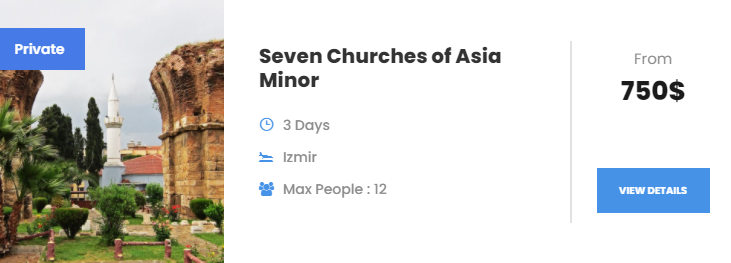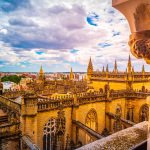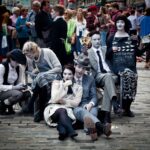Introduction
The Seven Churches of Revelation are a popular pilgrimage route in Turkey, though it takes some imagination and historical research to locate all of them.
In the book of Revelation, St. John addresses the seven churches of Asia Minor. In this highly symbolic, poetic book, St. John is writing during a time of persecution when he has been exiled to the island of Patmos on account of his missionary work. In his Revelation he describes a cosmic conflict between the forces of Satan and God’s angels, a battle that mirrors the earthly trials suffered by Christians at the hands of the Romans.
I, John, your brother and companion in the suffering and kingdom and patient endurance that are ours in Jesus, was on the island of Patmos because of the word of God and the testimony of Jesus. On the Lord’s Day I was in the Spirit, and I heard behind me a loud voice like a trumpet, which said: “Write on a scroll what you see and send it to the seven churches: to Ephesus, Smyrna, Pergamum, Thyatira, Sardis, Philadelphia and Laodicea. (Revelation 1:9-11)
The persecution that broke out after the murder of Stephen is often cited as the occasion for John coming to Ephesus. Acts 8:1 says that the church was scattered throughout Judea and Samaria; however, the apostles remained in Jerusalem. There is no biblical evidence that John went to Ephesus in the 30s. A more likely scenario is that John, heeding Jesus’ warning to flee Jerusalem when it was surrounded by Roman armies (Luke 21:20-21), moved with a community of Palestinian Jewish believers to Ephesus after the Jewish revolt broke out in 66 CE. Both Peter and Paul had recently been martyred in Rome under Nero, so John would have naturally filled their leadership vacuum. He ministered for some three decades to Christians in and around Ephesus, writing the Revelation, the Gospel and three Epistles. Related: Seven Churches of Revelation
As the leader of the Asian church John was targeted by Roman authorities and exiled to Patmos (Rev. 1:9). While on the island John received his apocalyptic vision about the spiritual situation of seven Asian churches as well as about the future of the church and the world (1:10-11, 19). The order of the seven churches – Ephesus, Smyrna, Pergamum, Thyatira, Sardis, Philadelphia, and Laodicea – follows a route that a messenger would naturally follow in visiting the cities. During Paul’s ministry in Ephesus many churches were established in Asia. Hence these seven churches seem to represent many other churches that were in Asia at the time (e.g., Miletus, Troas, Assos, Cyzicus, Magnesia, Tralles, Metropolis, etc.). The style of the seven messages is similar, with the heart of each focused on commendation and correction concluding with a promise of victory. The historical and spiritual situation of each church aids in interpreting the details of its message.
The addressees of the book of Revelation were seven churches in the Roman province of Asia. W. M. Ramsay states that the province “embraced the W. parts of the great peninsula now called Asia Minor, including the countries Mysia, Lydia, Caria, and great part of Phrygia, with the Dorian, Ionian, and Aeolian coast-cities, the Troad, and the islands off the coast (Lesbos, Chios, Samos, Patmos, Cos, etc.)” (“Asia”, Hastings Dictionary of the Bible, 1.171). Why these churches were singled out over other churches in the area has been an ongoing topic of discussion. The result of Paul’s 2 1/3 year residence in Ephesus (a.d. 52-54) was that “all the Jews and Greeks who lived in the province of Asia heard the word of the Lord” (Acts 19:10). Such widespread dissemination of the gospel thus occurred some two decades (early dating c. 69) or four decades (late dating c. 95) before Revelation was written.
Six other sites are certain locations of churches in the first century: Troas (Acts 16:8-11; 20:5-12; 2 Cor. 2:12; 2 Tim. 4:13), Miletus (Acts 20:15, 17; 2 Tim. 4:20), Colossae (Col. 1:2), Hieropolis (Col. 4:13), Tralles and Magnesia (Ignatius). Richard Oster has listed 37 Anatolian cities where Christian communities were established in the first and second centuries. None of the cities that follow are on his list, although he acknowledges that because such books as Revelation were designed as circular letters, this increases “the number of Christian sites that can be inferred from early Christian literature” (“Christianity in Asia Minor”, Anchor Bible Dictionary, 1.938). Other possible sites include Assos, which was approximately twenty miles overland from Troas via a Roman road, Mitylene, Chios, and Samos (Acts 20:13-15). Priene was an important Greek city along the route between Miletus and Ephesus, and Cyzicus was the most important Asian seaport on the Propontis (Sea of Marmara). The late E. M. Blaiklock suggested that Aphrodisias “will probably soon be added to the list of Ten Towns of Asia known to have been first-century centers of Christian witness” (NIDBA [ed. E. M. Blaiklock; Grand Rapids: Zondervan, 1983] 31).
In a personal letter responding to my question regarding the source of that assertion, Edwin Yamauchi wrote: “As I am not aware of any first-century evidence for Christians at Aphrodisias (and think it highly unlikely), I suspect that Dr. Blaiklock was probably guessing when he wrote on Aphrodisias” (May 3, 1992). The excavator of Aphrodisias, the late Kenan T. Erim, wrote: “The earliest known name of an Aphrodisian bishop is that of Ammonius, who participated in the Council of Nicaea in 325. Two early Christian martyrs, apparently put to death under Diocletian, were also ascribed to the city” (Aphrodisias: City of Venus Aphrodite [New York: Facts on File, 1986] 33). Given the prominence of Aphrodisias (re Augustus’ statement: “Aphrodisias is the one city from all of Asia I have selected to be my own” [ibid., 1]) and its proximity to the three churches of the Lycus valley, undoubtedly the gospel was preached there at an early date. No historical evidence has yet been discovered to verify the existence of a first- century church there, however.
Several of these cities are more prominent than Thyatira and Philadelphia. W. M. Ramsay has convincingly suggested that the order of the churches in Revelation represented a circular postal circuit that a courier would follow. Thus these churches were primary communication centers fcontentrom which secondary messengers would be dispatched so that other churches in their respective districts could read the correspondence. Revelation, then, was meant for a larger audience than the designated churches.
To the Church in Ephesus
to the angel of the church in Ephesus, write this:
The one who holds the seven stars in his right and walks in the midst of the seven gold lampstands says this : ” I know your works, your labor, and you endurance, and that you cannot tolerate the wicked; you have tested those who call themselves apostles but are not, and discovered that they are imposters.
Moreover, you have endurance and have suffered for my name, and you have not grown weary. Yet I hold this against you: you have lost the love you had at first. Realize how far you have fallen. Repent, and do the works you did at first. Otherwise, I will come to you and remove your lampstand from its place, unless you repent. But you have this in your favor: you hate the works of the Nicolaitans, which I also hate.”
“Whoever has ears ought to hear what the Spirit says to the churches. To the victor I will give the right to eat from the tree of life that is in the garden of God.”
(Rv 2:1-7)
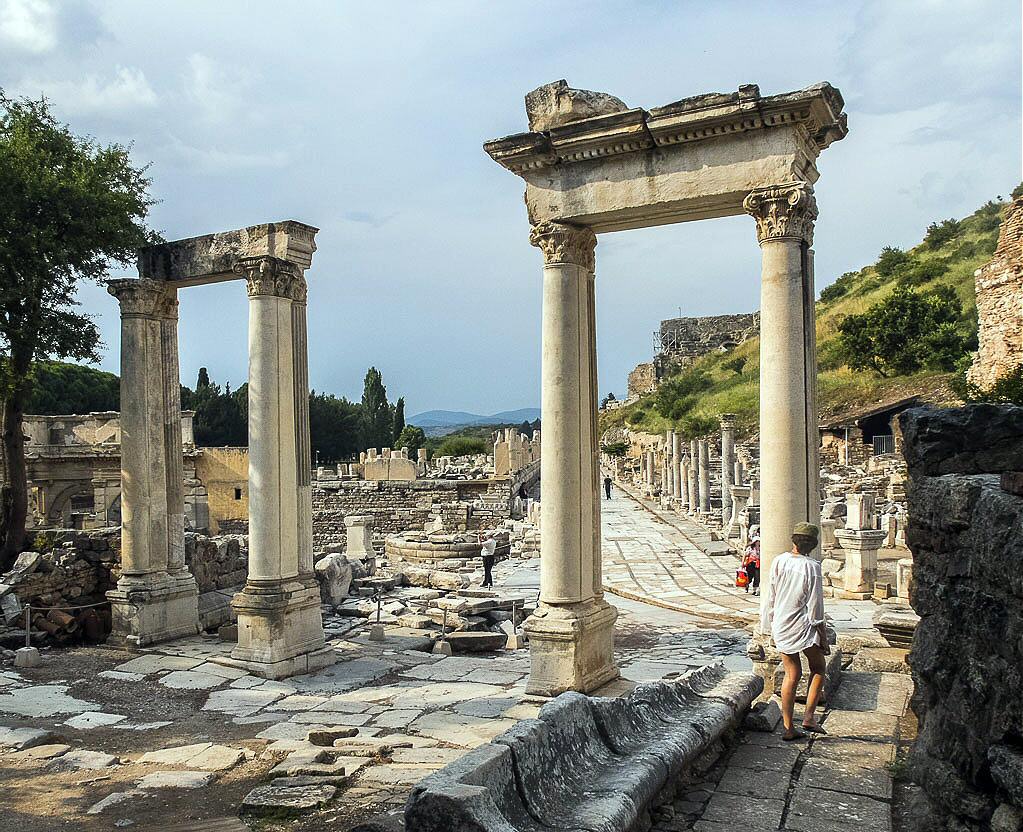
The church in Ephesus (2:1-7) was commended for its hard work and perseverance. The church encountered much spiritual opposition from the temple of Artemis as well as from the fourteen or more other Greek deities that were worshipped.
Ephesus was also a center of magical practices (Acts 19:19). False apostles in the church were also a problem. At Miletos St. Paul had warned the Ephesians elders that some from their own company would distort the truth (Acts 20:29-30). Timothy was to make the Ephesians Hymenaeus, Alexander, and Philetus stop teaching false doctrine (1 Tim. 1:3, 19-20; 2 Tim. 2:17-18). Related: Seven Churches of Revelation
Such external and internal conflict had caused the church to lose its first love of Christ and his saints. The site of Ephesus had moved three times during its early history. Unless the church repented, Jesus threatened to move its lampstand from its place of prominence among the Asian churches. (It does not mean Jesus would do away with the church.)
The victorious Christians in Ephesus were were promised to eat of the tree of life in the paradise of God. Paradise was the name for the Garden of Eden in the Greek Old Testament. Outside Ephesus was the grove Ortygia which was thought to be the traditional birthplace of Artemis.
The sacred grove called a paradeisos still drew pilgrims in the first century. The Christians were thus promised an eternal paradise far superior to that possessed by their pagan counterparts.
To the Church in Smyrna
to the angel of the church in Smyrna, write this:
The first and the last, who once died but became to life, says this : “I know your tribulation and poverty, but you are rich. I know the slander of those who claim to be Jews and are not, but rather are members of the assembly of Satan. Do not be afraid of anything that you are going to suffer. Indeed, the devil will throw some of you into prison, that you may be tested, and you will face an ordeal for ten days. Remain faithful until death, and I will give you the crown of life.
“Whoever has ears ought to hear what the Spirit says to the churches. The victor shall not be harmed by the second death.”
(Rv 2:8-11)
The church in Smyrna (2:8-11) had experienced great pressure from the Jewish authorities, called the synagogue of Satan. No archaeological evidence exists today for such a synagogue. It had closed its doors to Christians, and its leaders were inciting the Roman authorities to persecute the church.
The Jews later had a similar role in the martyrdom of the bishop of Smyrna, Polycarp. The crown of life is a possible allusion to the acropolis Mount Pagus that looms over the city. Such ancient writers as Aristides describes it as Smyrna’s crown. Whatever temporal crown the citizens of Smyrna enjoyed, the believers were guaranteed an eternal crown.
They were also promised exemption from the second death. There existed in the ancient world a connection between death and Smyrna. Its name is identical to the Greek word for the sweet-smelling spice in which dead bodies were wrapped (e. g., Jesus; John 19:39).
A number of mourning myths became associated with Smyrna, particularly that of Niobe whose tear-stained face was thought to be etched in the marble of nearby Mount Sipylus.
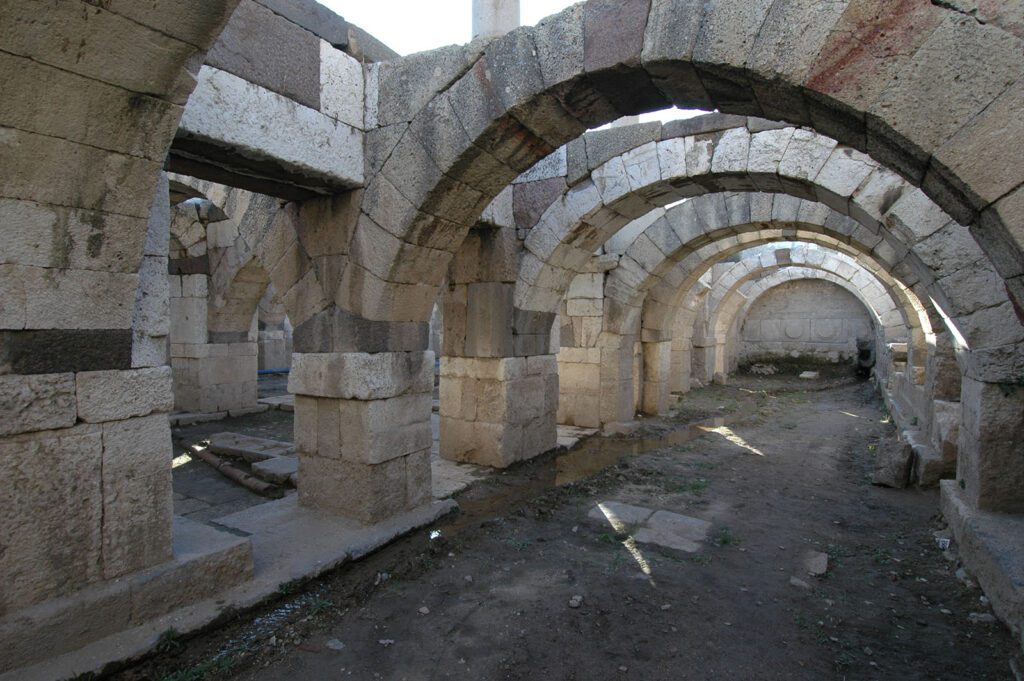
To the Church in Pergamon
to the angel of the church in Pergamon, write this:
The one with the sharp two-edged sword says this : ‘I know that you live where Satan’s throne is, and yet you hold fast to my name and have not denied your faith in me, not even in the days of Antipas, my faithful witness, who was martyred among you, where Satan lives. yet I have a few things against you. you have some people there who hold to the teaching of Balaam, who instructed Balak to put a stumbling block before the Israelites: to eat food sacrificed to idols and to play the harlot. Likewise, you also have some people who hold to the teaching of (the) Nicolaitans. Therefore, repent. Otherwise, I will come to you quickly and wage war against them with the sword of my mouth.
Whoever has ears ought to hear what the Spirit says to the churches. To the victor I will some of the hidden manna; I shall also give a white amulet upon which is inscribed a new name, which no one knows except the one who received it.”
(Rv 2:12-17)
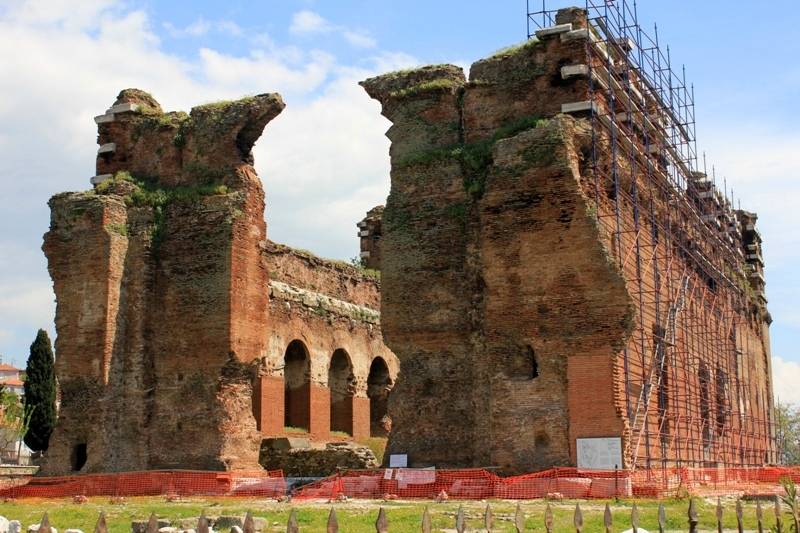
The church in Pergamon (2:12-17) existed in the place where Satan had his throne. This reference probably does not refer to the altar of Zeus that sat atop the thousand-foot acropolis that towers over the lower city. Rather it refers to the city as the seat of the provincial koinon, or assembly, whose leader was also the chief priest (“the beast out of the earth”; 13:11-17) of the imperial cult-the first cult temple in Anatolia.
The Roman governor of Asia exercised the power of life and death-the “right of the sword” (ius gladii)-in his province. Jesus stated he held even higher authority with his sharp, double-edged sword. One church leader named Antipas had already been martyred in the city. He was the only person named in Book of Revelation as a martyr. The imperial cult temple housed a white stone stele inscribed with a decree issued by Fabius, the governor of Asia, around 9 B.C.
It decreed that Augustus’ birthday should be made an official holiday in Asia as well as mark the beginning of the municipal new year. Related: Seven Churches of Revelation
The birth of Caesar Augustus was called the beginning of life and breath (cf. Rev. 3:14). And his birthday was declared the beginning of good news for the world (cf. Rev. 14:6). The emperors made the same claims to deity as Jesus Christ! No wonder the Christians refused to take the mark of this beast and worship him.
To the Church in Thyatira
to the angel of the church in Thyatira, write this:
The Son of God, whose eyes are like a fiery flame and whose feet are like polished brass, says this ” I know your works, your love, faith, service, and endurance, and that your last works are greater than the first. Yet I hold this against you, that you tolerate the woman Jezebel, who calls herself a prophetess, who teaches and misleads my servants to play the harlot and to eat food sacrificed to idols. I have given her time to repent, but she refuses to repent of her harlotry.
So I will cast her on a sickbed and plunge those who commit adultery with her into intense suffering unless they repent of her works. I will also put her children to death. Thus shall all the churches come to know that I am the searcher of hearts and minds and that I will give each of you what your works deserve. But I say to the rest of you in Thyatira, who do not uphold this teaching and know nothing of the so-called deep secrets of Satan: on you I will place no further burden, except that you must hold fast to what you have until I come.
“To the victor, who keeps to my ways until the end, I will give authority over the nations. He will rule them with an iron rod. Like clay vessels will they be smashed, just as I received authority from my Father. And to him I will give the morning star.”
“Whoever has ears ought to hear what the Spirit says to the churches.”
(Rv 2:18-29)
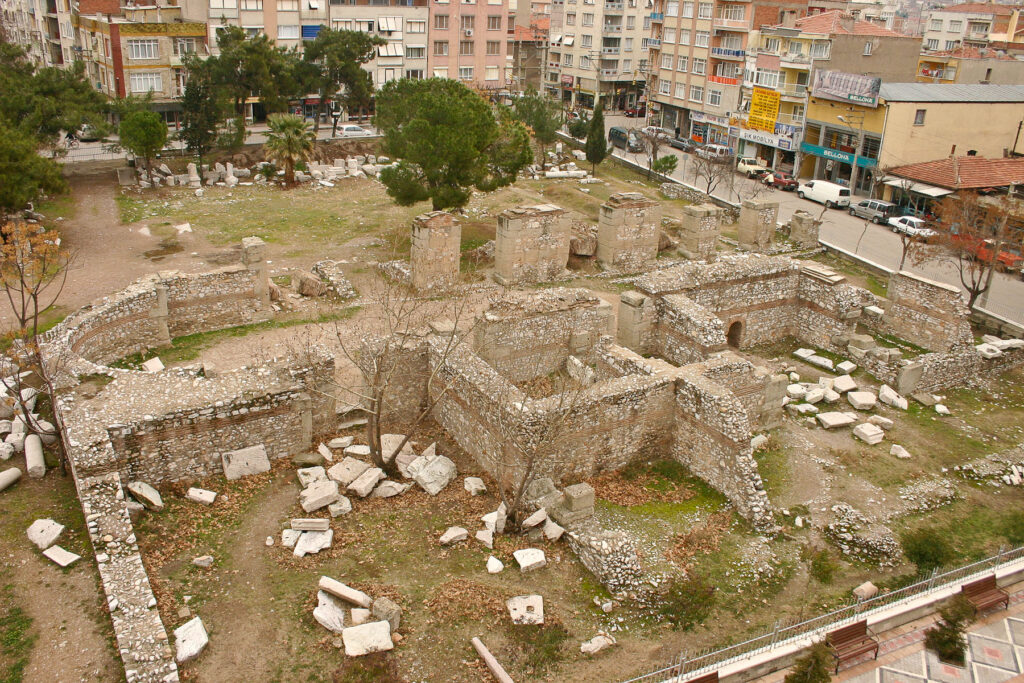
The church in Thyatira (2:18-29) was plagued by a false prophetess symbolically named Jezebel after the evil queen of Israel who worshiped idols. She along with the Nicolaitans advocated compromise with certain pagan practices. Meat in the ancient world was dedicated to the gods at the pagan temples before it was sold in the public markets; many Christians refused to eat such meat sacrificed to idols.
Thyatira was known for its trade guilds (cf. Lydia; Acts 16:14) which would hold banquets in the pagan temples. After eating and drinking, the diners often engaged in sexually immoral acts on the couches (klinai) where they lay. Jezebel and the Nicolaitans apparently condoned such behavior because of a false understanding of freedom in Christ.
To the Church in Sardis
to the angel of the church in Sardis, write this:
The one who has the seven spirits of God and the seven stars says this: ‘I know your works, that you have the reputation of being alive, but you are dead. Be watchful and strengthen what is left, which is going to die, for I have not found your works completely in the sight of my God. Remember then how you accepted and heard; keep it, and repent.
If you are not watchful, I will come like a thief, and you will never know at what hour I will come upon you. However, you have a few people in Sardis who have not soiled their garment; they will walk with me dressed in white, because they are worthy. The victor will thus be dressed in white and will never erase his name from the block of life but will acknowledge his name in the presence of my Father and of his angels.
“Whoever has ears ought to hear what the Spirit says to the churches.”
(Rv 3:1-6)
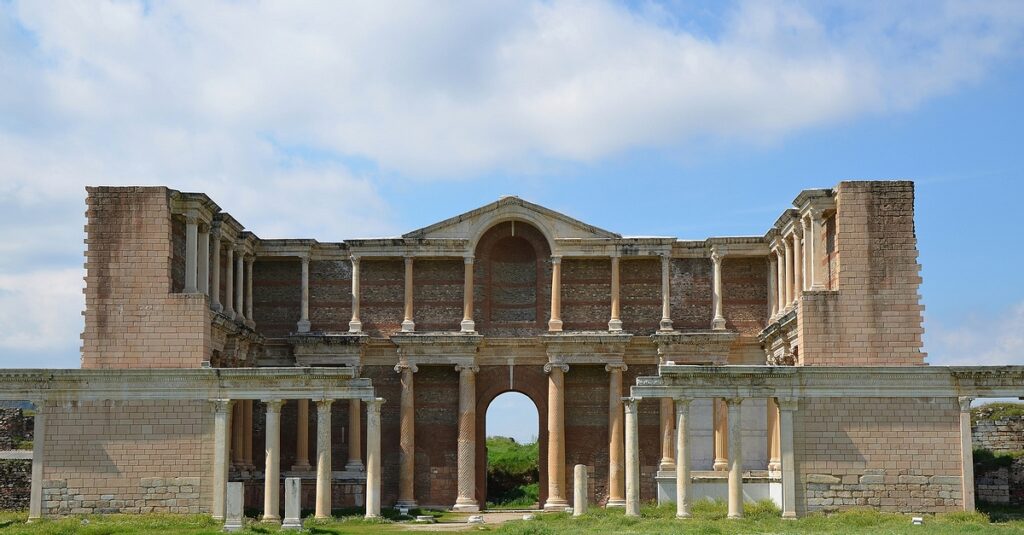
The church in Sardis (3:1-6) had become dead in spite of its reputation. Twice before the city’s acropolis had fallen because Sardis had fallen asleep and let down her guard. Cyrus defeated Croesus in 546 B.C., and the Cretan general Lagoras captured it for Antiochus the Great in 218 B.C. Greek cities maintained a list of citizens in a public register.
When someone committed a criminal action and was condemned, he lost his citizenship and his name was then erased from the register. The believers who preserved would never be blotted from the eternal book of life.
Sardis was noted as a textile center, producing wool to make the himation, the most common outer garment for men and women in the Greco-Roman world. The color white in Book of Revelation always denotes purity and worthiness. Hence white garments would be a suitable reward for the victors.
To the Church in Philadelphia
to the angel of the church in Philadelphia, write this:
The holy one, the true, who holds the key of David, who opens and no one shall close, who closes and no one shall open, says this: “I know your works (behold, I have left an open door before you, which no one can close). You have limited strength, and yet you have kept my word and have not denied my name. Behold, I will make those of the assembly of Satan who claim to be Jews and are not, but are lying, behold I will make them come and fall prostrate at your feet, and they will realize that I love you.
Because you have kept my message of endurance, I will keep you safe in the time of trial that is going to come to the whole world to test inhabitants of the earth. I am coming quickly. Hold fast to what you have, so that no one may take your crown.
The victor I will make into a pillar in the temple of my God, and he will never leave it again. On him I will inscribe the name of my God and the name of the city of my God, the new Jerusalem, which comes down out of heaven from my God, as well as my new name.”
“Whoever has ears ought to hear what the Spirit says to the churches.”
(Rv 3:7-13)

The church in Philadelphia (3:7-13) stood at an important junction of the imperial post road that ran from Rome through Troas, Pergamum, and Sardis on through to Tarsus and the East. They had an open door through which to share the gospel.
Yet here too a synagogue of Satan opposed the believers. Although no archaeological evidence for a synagogue has been found, a 3rd-century A.D. inscription was found 10 miles east of the city mentioning a “synagogue of the Hebrews”. Philadelphia was located in an earthquake-prone region called the Catacecaumene.
Both Sardis and Philadelphia were devastated by earthquakes in A.D. 17. Asian temples were built to withstand severe earthquakes. Their foundations were laid on beds of charcoal covered with wool fleeces, which caused the structure to “float” on the soil like a raft. Each block was joined to another by metal cramps, so that the platform was a unity. Related: Seven Churches of Revelation
The temple would be the most secure structure in the city, hence the promise to be a pillar in the temple of God was one of security and safety. Inscribed pillars are found throughout Aegean Turkey. A dramatic example is the temple of Zeus at Euromos with dedicatory inscriptions on ten of the eleven standing pillars. Jesus will write divine names as well as his new name on those human “pillars” who overcome.
Philadelphia received a new name twice in the first century: the first time after the A.D. 17 earthquake to “Neocaesarea” in gratitude for Tiberius’ generosity, the second time to “Flavia” after Vespasian gave financial assistance following a similar catastrophe.
To the Church in Laodicea
to the angel of the church in Laodicea, write this:
The Amen, the faithful and true witness, the source of God’s creation says this: “I know that you are neither cold nor hot. I wish you were either cold or hot. So, because you are lukewarm, neither hot or cold, I will spit you out of my mouth. for you say, ‘I am rich and affluent and have no need of anything,’ and yet do not realize that you are wretched, pitiable, poor, blind, and naked.
I advise you to buy from me gold refined by fire so that you may be rich, and white garments to put on so that your shameful nakedness may not be exposed, and buy ointment to smear on your eyes so that you may see. Those whom I love, I reprove and chastise.
Be earnest, therefore, and repent. Behold, I stand at the door and knock. If anyone hears my voice and opens the door, (then) I will enter his house and dine with him, and he with me. I will give the victor right to sit with me on my throne, as I myself first won the victory and sit with my Father on his throne.’
“Whoever has ears ought to hear what the Spirit says to the churches.”
(Rv 3:14-22)

The church in Laodicea (3:14-22) was closely related to its sister church in Colossae and Hierapolis. Its spiritual condition was lukewarm-neither hot nor cold. Six miles north of the city were the thermal springs (not drinkable) at Hierapolis, whose white calcareous cliffs were visible in the distance.
To obtain drinking water, the Romans built an aqueduct that ran five miles south to an abundant spring (now in Denizli). The cool spring water would become lukewarm as it passed through the aqueducts into the city. The city was strategically located for trade and commerce, and became a leading banking center. It had accepted aid from Rome following earlier earthquakes. Related: Seven Churches of Revelation
However, after the earthquake in 60 that devastated many Asian cities, only Laodicea refused to accept Roman financial assistance because she was so wealthy. This attitude of material self-satisfaction, “I am rich,” had seemingly entered the church also. The church’s spiritual blindness was ironic because a famous salve for treating eye disease was produced by the medical school there.
The exhortation to buy white garments to cover their shameful nakedness is another example of irony. For the believers were living in a city where the Romans had established textile factories to manufacture clothing from the famous black wool of the region. Laodicea was a “throne city” because a citizen Zeno became king of Cilicia in 39 B.C. and of Pontus in 36.
His family continued to rule in some measure in Anatolia over the next century. The Zenoid family figures prominently on the Laodicea’s coinage. Again the victors are promised that they will sit with Jesus on his heavenly throne.

